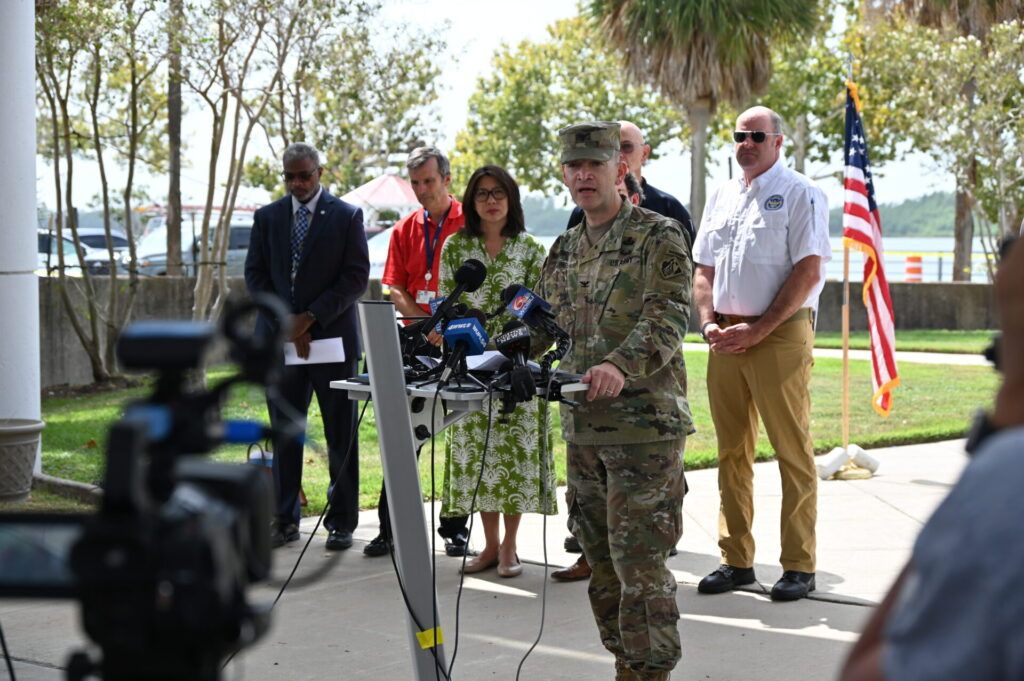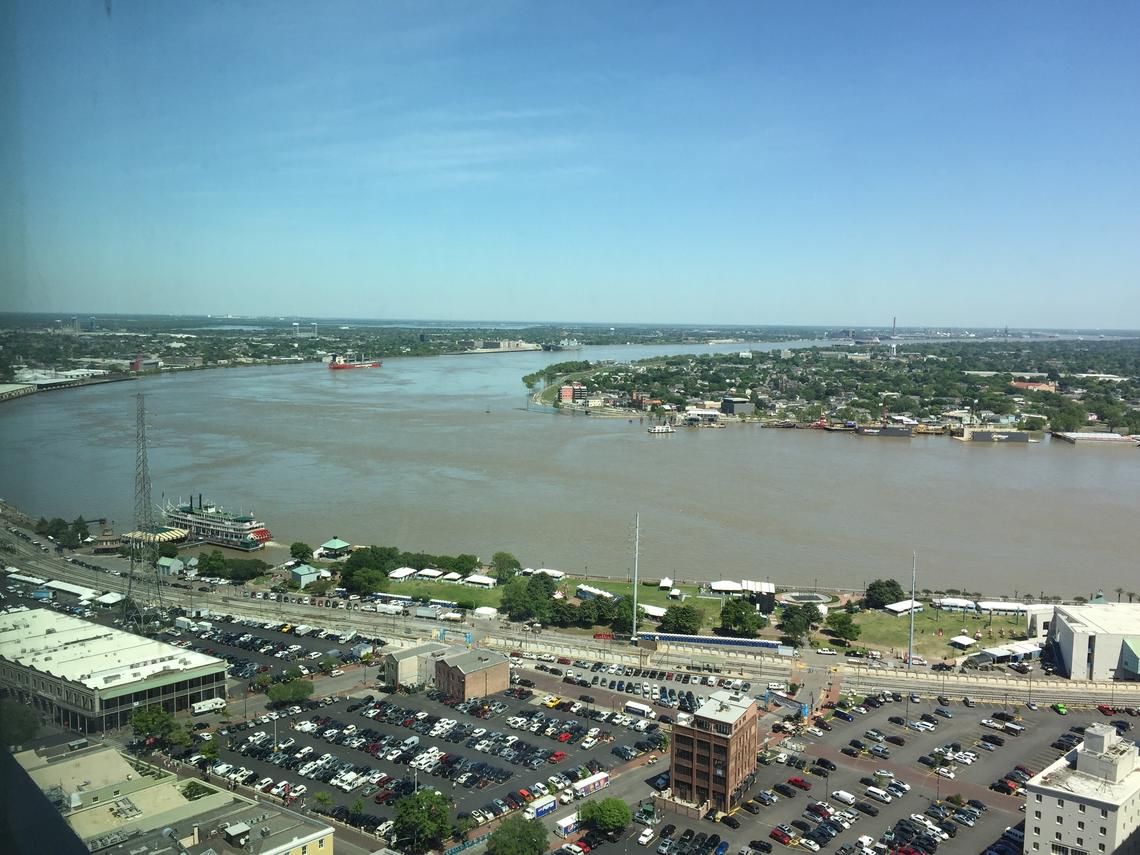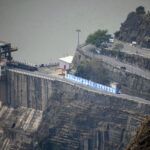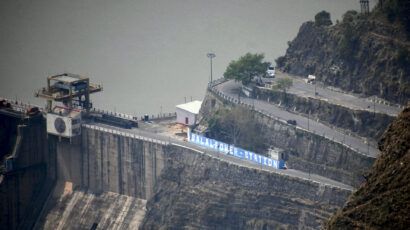The saltwater wedge may spare New Orleans, but it’s still a crisis
By Jessica McKenzie | October 20, 2023
 The US Army Corps of Engineers New Orleans District announces the new timeline for the saltwater intrusion at a press conference on October 5, 2023. (Team New Orleans, US Army Corps of Engineers/Flickr)
The US Army Corps of Engineers New Orleans District announces the new timeline for the saltwater intrusion at a press conference on October 5, 2023. (Team New Orleans, US Army Corps of Engineers/Flickr)
The climate crisis continues to throw unexpected curveballs at cities and regions around the world, like the saltwater intrusion threatening the drinking water supply of the 1.2 million people in the New Orleans metropolitan area, which prompted President Joe Biden to declare a state emergency.
Earlier this month, the city received some welcome news: The wedge of saltwater that had been steadily advancing from the Gulf of Mexico up the Mississippi River had stalled, staving off a drinking water crisis in the city until late November, at least. A few days later, the wedge had retreated by more than five miles, giving the entire region even more breathing room.
Officials are still tentatively moving forward with emergency plans to safeguard the water supply, if necessary, including building a pipeline to bring in freshwater from further upstream to dilute the salinity of water at the city’s water treatment plants. (It’s unhealthy and eventually fatal for people to drink water above a certain salinity, and desalinating water is extremely expensive.) That pipeline would take up to 45 days to construct and could cost up to an estimated $250 million.
Although the saltwater wedge didn’t make national headlines until it began threatening New Orleans, smaller communities downriver have been without drinking water since June. Even if the city is spared—this year at least—it has revealed some crucial vulnerabilities in the region.
“The water that’s typically delivered through our centralized water distribution systems in the United States, you turn on the tap and you drink it. It’s supposed to be safe and good,” Stephen Murphy, the director of the disaster management program at Tulane University’s School of Public Health & Tropical Medicine, told me when we met in his office earlier this month. “Now we’re facing a crisis where it might not be.”
Why is this happening? Several factors have contributed to the saltwater intrusion. The first is the drought in the Mississippi and the Ohio River valleys, which has weakened the flow rate of the Mississippi River. The second is the dredging of the bottom of the Mississippi River to allow larger ships to travel upriver to Louisiana ports. This creates more space for the heavier saltwater to move in.
These are not new issues. The Army Corps of Engineers has been dredging the river since the 19th century, and in 1936, during the Dust Bowl, the city’s drinking water reached salt levels of 388 parts per million, which is 55 percent higher than current federal standards. Saltwater nearly reached the city’s water supply again during a historic drought in 1988. That year, and then again in 1999, 2012, 2022, and 2023, the Army Corps built a barrier of silt and debris on the river floor called a sill to block the saltwater. In September of this year, the saltwater wedge ‘overtopped’ the sill, and the Army Corps rushed to raise it by 25 feet.
But it’s hard not to notice that the frequency of these saltwater intrusion events seems to be increasing due to more dramatic, climate change-related droughts and heat waves.

What now? Now that the immediate crisis has lessened, the focus has turned to the future.
“This is going to be a recurring issue,” Murphy said. “It’s already a recurring issue for those downriver parishes and communities. We’ve got to figure a permanent solution out.”
Murphy said that the planned pipeline would bring in enough water to make the salinity content of the water manageable, even if the wedge reached New Orleans. “However, I don’t think that is a permanent solution. I think we need to think bigger.”
“As we continue to grapple with the changes that our climate is throwing at us, we’ve got to realize that we need to try to overcome this, as opposed to battle it every year,” Murphy added. “If we’re going to support the dredging—which I think we should, because it’s a very important piece of our United States commerce that comes up this port—we have to recognize that it’s being compounded and more deeply impacted by the climate. So we have to figure that out. The dredging of the river does, in part, contribute to it. But the volume of water coming down the river is the problem. And that problem won’t be solved on its own. And we’ve got to find a better, more permanent solution to our water.”
Shifting priorities and ‘hard decisions.’ In recent years, New Orleans has been focused more on flood and storm mitigation than on drinking water.
“Our community, our leadership, our research funding, has really been focused on stormwater management and flooding for the last, you know, since [Hurricane] Katrina, and at the expense of the drinking water system,” Tyler Antrup, a visiting assistant professor at the Tulane School of Architecture and green infrastructure expert, explained as we walked along the river near downtown New Orleans. “Not to say that it’s in a crisis already in itself, outside of this scenario, but it’s not out of the realm of possibility that it could be.”
Antrup, who also serves on the New Orleans Sewerage and Water Board, expressed hope that this crisis, or this potential near-miss, will wake people up to the need to protect and improve the city’s drinking water system.
“Something that I’ve experienced for a long time in a place like this … is that while we’ve all gotten really skilled at multitasking when there are multiple crises occurring, it’s hard to keep your eye on the ball of longer term, more forward-looking work.”
Murphy also spoke about the need to shift funding priorities. “Hardening that, making this more resilient … all of those people need to come together again and say, ‘Wait a minute, maybe that shouldn’t be our focus.’ Now, maybe we need to relax some of the money that’s going to go over here, over there. And we need to start really reshaping how we’re going to actually draw water to drink and survive.”
“Mitigation dollars should be considered in other avenues. You know, I don’t know the perfect solution,” Murphy said. “I think a lot of times, we get lost in the other facets of the hazard mitigation process and the resilience process. And so, some of those hard decisions are going to have to be made.”
One much-needed infrastructure improvement that could help the New Orleans water system overall, Murphy said, is new pipes. “We lose about 40 percent of minimum of our water between the source and the tap, just based on leaking pipes,” he said.
Another would be to replace the aging East Bank water treatment plant, which is about 100 years old. “It’s no secret that it’s far beyond its useful life,” Antrup said. “There have been plans, tentative plans, in place for a long time to really begin replacing that plant in earnest.” With all the focus and concern about New Orleans drinking water, it seems more likely that the city will be able to marshal the funds and the urgency necessary to do that now.
“This is an opportunity for us to really rethink our source water, to rethink our treatment processes, to rethink the location of our treatment plant,” Antrup said. “All of those things, I think, can and should be on the table.”
“I’m excited about more thought and research and study going into this issue, and I think that will happen now, and I hope that the Corps and the Congress appropriate the right amount of funding and resources for them to be able to do that,” Antrup added. “Particularly, when we’re looking at Congress appropriating funds for dredging, you know, it would be great if we could see additional funds for mitigation that can be used by water utilities and by local organizations to do this work.”
Restoring trust. Part of Antrup’s job on the Sewerage and Water Board has been to reassure people that the water continues to be safe to drink. Communicating the risks has been a challenge. “I think that could be part of what is driving some level of uncertainty, particularly amongst the residents, with this type of situation,” Antrup explained. “We’re accustomed to being told a week out when we can expect a hurricane to come. In this case, you know, we’re saying like, maybe in a month, and now it’s like, maybe in two months, but probably not even, but maybe. And I think that’s hard for us to process because we’re so accustomed to like, ‘there’s a category four coming in three days, everybody pack up your stuff and do what you always do.’ … This is just a different type of event.”
A more diffuse challenge is the disconnection between much of the population of New Orleans and the river. “There’s always been a bit of tension between the shipping industry and the city. Obviously, for a long time it was like our lifeblood,” Antrup said. “It continues to be one of the largest segments of our economy, but less of an employment driver than it used to be, as it’s become more automated and mechanized. People are appreciative of the fact that we are a strategic national asset in terms of our port, but a lot of people are no longer directly benefiting from the shipping industry.”
When the Army Corps decided to dredge the river again a few years ago, Antrup said there wasn’t any kind of public discussion process around that, it was just announced. “A lot of folks here don’t understand the way that the river works,” Antrup said. “We’re not expecting everyone to be hydrologists. But, you know, I think the fact that the primary driver of this event is a drought in the Ohio River Valley is something that is very difficult for an average resident to understand. I was just saying to a colleague last night, we need to work on, you know, how do we better demystify the whole watershed for our residents, because it passes by our front door.”
That responsibility is on institutions. “When the Sewerage and Water Board says, ‘we’re going to make sure to maintain a safe source of water,’ I think people want to hear more, and they want to hear how,” Antrup said.
The Army Corps has begun publishing regular saltwater forecasts which should help with a piece of the education on water issues, or at least allow residents to monitor the situation.
Global lessons. While there are many aspects that make the situation in New Orleans unique, there are lessons to be learned elsewhere, like the Netherlands.
“I’ve had a lot of really interesting conversations with Dutch hydrogeologists about looking at alternative sources for drinking water, and I think this will inspire us to continue those conversations and deepen our exchange,” Antrup said. “That exchange has been dedicated to stormwater management, but I think we have a lot to learn from them as well on this.”
More generally, saltwater intrusion into groundwater aquifers is a global problem exacerbated by sea level rise, drought, and human activity, like groundwater pumping. This threatens ecosystems, agriculture, and drinking water.
Tampa Bay, for example, historically relied on groundwater aquifers to provide drinking for its 2.5 million residents. Anticipating the threat of saltwater intrusion, the city invested $158 million into a desalination plant that was completed in 2008. Now, the city uses a mix of groundwater, surface water, and desalinated water to provide for its residents. That could be a model for New Orleans, too, if it comes to it.
“This is not a permanent condition that we’re anticipating,” Antrup said. “Obviously, you know, there is a potential that in the future with sea level rise, we could see saltwater intruding into the river more permanently, but we’re not there yet.”
The final thought Murphy wanted to leave me with? “The water is safe,” he said. “You can drink it today. That’s a big message that New Orleans needs to get out there.”
Together, we make the world safer.
The Bulletin elevates expert voices above the noise. But as an independent nonprofit organization, our operations depend on the support of readers like you. Help us continue to deliver quality journalism that holds leaders accountable. Your support of our work at any level is important. In return, we promise our coverage will be understandable, influential, vigilant, solution-oriented, and fair-minded. Together we can make a difference.
Keywords: Louisiana, drinking water, drought, new orleans, sea level rise, water crisis
Topics: Climate Change















